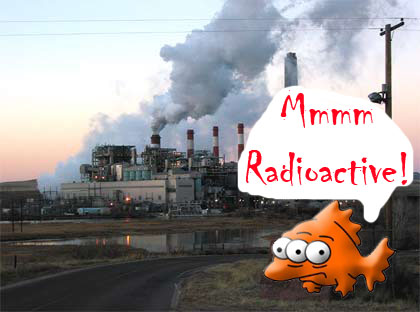
So most people think of nuclear bombs, and nuclear power plants when people say the words “radioactive waste.” It turns out however that there is a sneaky source of radioactivity hiding in the friendly neighborhood coal power plant. Coal like most other substances on the planet has tiny trace amounts of radioactivity (even bananas), most of these substances are hardly more dangerous than going out in the sun. Coal however is in the nasty habit of being dug up and burned by humans eager to get at its tasty carbon rich stored solar energy. This burning process has the net effect of sending a good portion of that coal out into the world in the form of mercury, sulfur, co2, and other noxious chemicals, though the smokestack. What is left over is known in the industry as fly ash, and surprise surprise the stuff is wicked radioactive.
At issue is coal’s content of uranium and thorium, both radioactive elements. They occur in such trace amounts in natural, or “whole,” coal that they aren’t a problem. But when coal is burned into fly ash, uranium and thorium are concentrated at up to 10 times their original levels.
Fly ash uranium sometimes leaches into the soil and water surrounding a coal plant, affecting cropland and, in turn, food. People living within a “stack shadow”—the area within a half- to one-mile (0.8- to 1.6-kilometer) radius of a coal plant’s smokestacks—might then ingest small amounts of radiation. Fly ash is also disposed of in landfills and abandoned mines and quarries, posing a potential risk to people living around those areas.
In a 1978 paper for Science, J. P. McBride at Oak Ridge National Laboratory (ORNL) and his colleagues looked at the uranium and thorium content of fly ash from coal-fired power plants in Tennessee and Alabama. To answer the question of just how harmful leaching could be, the scientists estimated radiation exposure around the coal plants and compared it with exposure levels around boiling-water reactor and pressurized-water nuclear power plants.
The result: estimated radiation doses ingested by people living near the coal plants were equal to or higher than doses for people living around the nuclear facilities. At one extreme, the scientists estimated fly ash radiation in individuals’ bones at around 18 millirems (thousandths of a rem, a unit for measuring doses of ionizing radiation) a year. Doses for the two nuclear plants, by contrast, ranged from between three and six millirems for the same period. And when all food was grown in the area, radiation doses were 50 to 200 percent higher around the coal plants.(via)
There are plenty of reasons to hate coal plants, acid rain, mountain top removal, mining deaths, air pollution, mercury, sulfur, but lets be honest here, you are not going to glow in the dark because you live near a coal plant.
McBride and his co-authors estimated that individuals living near coal-fired installations are exposed to a maximum of 1.9 millirems of fly ash radiation yearly. To put these numbers in perspective, the average person encounters 360 millirems of annual “background radiation” from natural and man-made sources, including substances in Earth’s crust, cosmic rays, residue from nuclear tests and smoke detectors.
Dana Christensen, associate lab director for energy and engineering at ORNL, says that health risks from radiation in coal by-products are low. “Other risks like being hit by lightning,” he adds, “are three or four times greater than radiation-induced health effects from coal plants.” And McBride and his co-authors emphasize that other products of coal power, like emissions of acid rain–producing sulfur dioxide and smog-forming nitrous oxide, pose greater health risks than radiation.
What we should be worrying about is that if we continue to burn coal for energy the elevated green house emissions will lead to catastrophic global warming which has the potential to destroy our civilization as we know it (and oh by the way its radioactive). In my opinion this is but one more nail in coals coffin. Radioactive, dirty, hard to dig up, and increasingly expensive, coal is an old fashion and dangerous way to make energy. I for one say good riddance to nasty filthy no good coal. Long live renewable energy, the safe, clean, sustainable energy source.
I found this fact sheet from the USGS (http://pubs.usgs.gov/fs/1997/fs163-97/FS-163-97.html)
It concurs that our radioactive exposure from coal and fly ash (which is often a “recycled content” additive in concrete products) is minuscule when compared to the radiation we get from naturally occurring radon and even medical x-rays.
My question is this: Is it better to have another nail in the coffin, even if its weakness could detract from stronger negatives such as air quality, greenhouse gases, and mountaintop removal?
PS- Those “Friends of Coal” billboards along I-77 in West Virginia scare me.